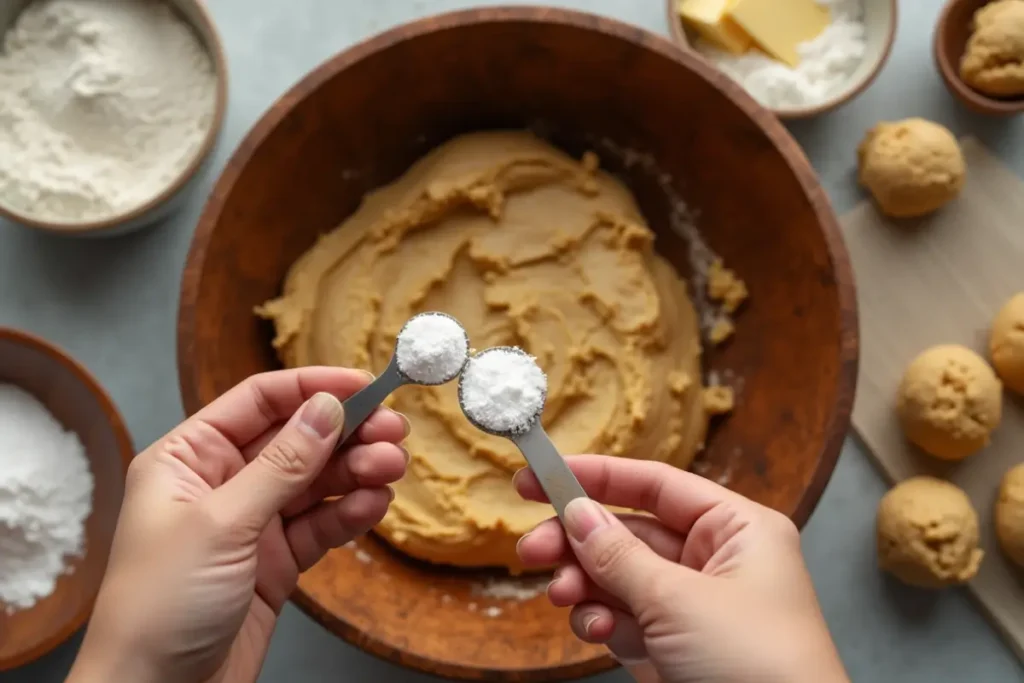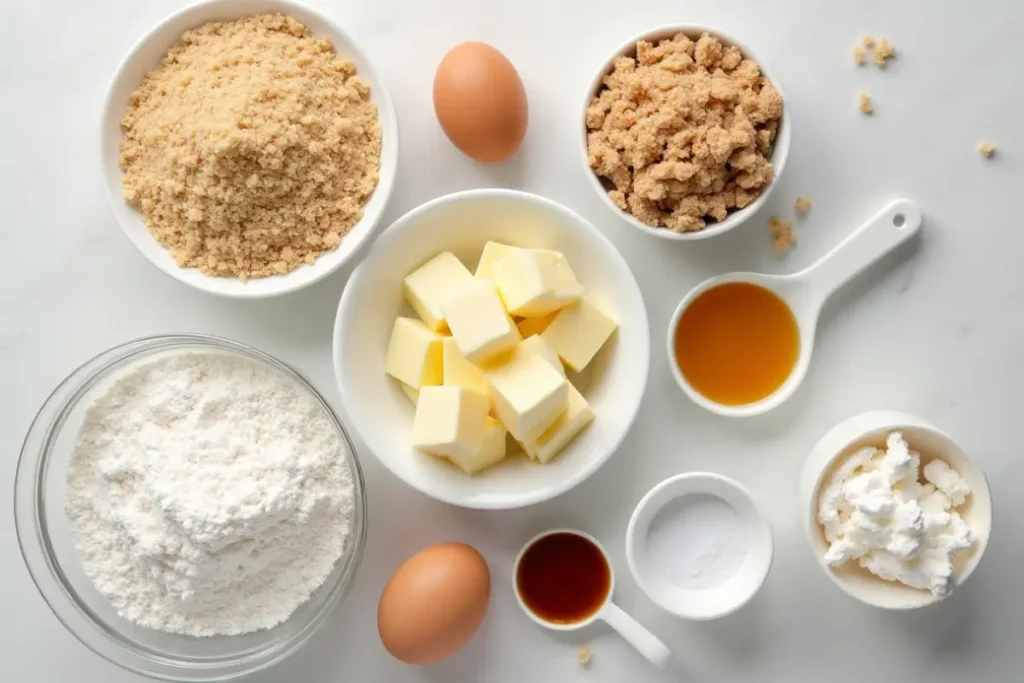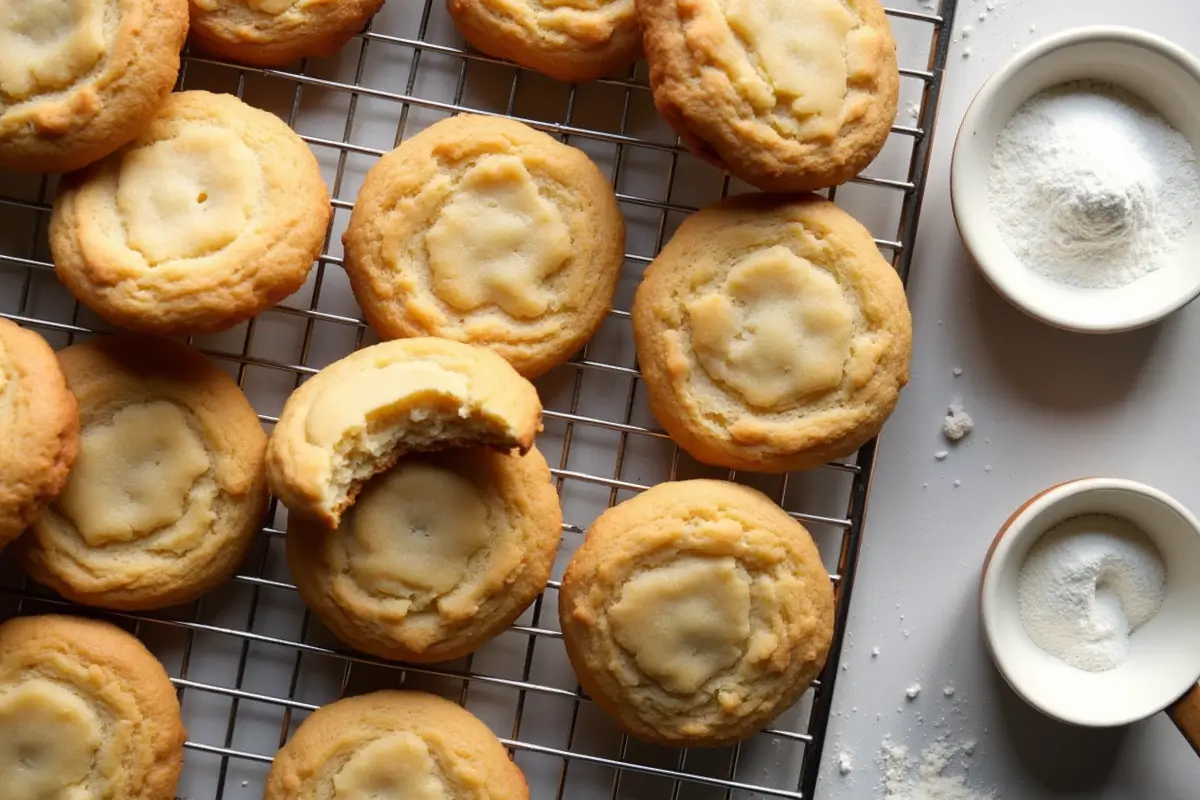Have you ever baked a batch of cookies, eagerly anticipating that perfect balance of chewiness and crisp, only to be met with flat, spreading disks? Or perhaps, those cookies had a texture that was less than desirable? I remember those days. It’s a common frustration, and one I faced more times than I’d like to admit. Like so many, I struggled with how to achieve the desired cookie texture. Baking, as wonderful as it is, can be tricky; it’s a science as much as an art, and sometimes, the answer to the question “What does cream of tartar do in cookies?” becomes the secret to success.
For a long time, I found myself searching for that missing piece, that secret ingredient that would take my cookies from average to amazing. That’s when I discovered cream of tartar – a humble white powder with a surprisingly powerful impact on your baking endeavors. This seemingly insignificant addition can make all the difference between cookie catastrophes and cookie masterpieces.
In this article, you’ll journey with me through the world of cream of tartar, and together, we’ll unlock the secret to perfect cookies.
Understanding Cream of Tartar: More Than Just a White Powder
You might see cream of tartar listed in your favorite cookie recipe and wonder, “What exactly is this stuff?”. It definitely sounds like it should be creamy. Surprisingly, it’s not a dairy product at all! In fact, it’s a dry, acidic byproduct from winemaking. It’s a natural substance that forms inside wine barrels after fermentation. Chemically, cream of tartar is known as potassium bitartrate, a compound that is naturally derived from grapes. When you use it in your baking, you’re incorporating the results of a natural chemical reaction. It’s not just any ordinary white powder; it’s a critical player in the world of baking. Knowing where it comes from and what it is will give you an even greater understanding of its role in cookie perfection.
The Vital Role of Cream of Tartar in Cookie Texture

Now, let’s dive deeper into how this seemingly simple powder works its magic. The most significant impact of cream of tartar in your cookies lies in its ability to modify the texture. Its superpower lies in how it interacts with other ingredients, especially baking soda. Cream of tartar, with its acidic nature, acts as a counterpart to the alkaline baking soda, and when these two come together, a chemical reaction occurs that creates carbon dioxide gas. This process is known as leavening. This gas is trapped within your dough, causing it to rise during baking, resulting in cookies that are wonderfully light and fluffy, rather than dense and flat.
Furthermore, cream of tartar plays an important role in controlling the spread of your cookies. When added to your dough, it helps strengthen the gluten structure, giving your cookies a more defined shape. The acid also prevents sugar from crystallizing excessively as it bakes. This is crucial for achieving that perfect chewiness we all love. Without cream of tartar, the sugar might recrystallize in an undesirable way, making your cookies either hard or grainy. So, if you’ve ever struggled with cookies that spread too thin or had an uneven texture, cream of tartar might be your solution. It’s not just a random ingredient; it’s a structural and textural essential.
How Cream of Tartar Affects the Structure of Cookies
Let’s get a little more specific about how cream of tartar interacts with your dough’s components. One of the main ways it affects your cookie’s structure is by influencing the gluten development in your dough. Gluten is the protein in wheat flour that, when mixed with water, forms a stretchy, elastic network. Too much gluten development can lead to cookies that are too tough or dense. Cream of tartar limits gluten from stretching excessively in your dough. It inhibits the gluten strands from becoming too long, which in turn, yields a more delicate and softer cookie. If you notice a pattern of cookies being too chewy, consider adding a small amount of cream of tartar to regulate gluten development.
Moreover, cream of tartar assists in controlling the crystallization of sugar during baking. When sugar crystals melt during the baking process, they are prone to recrystallizing in large clumps as they cool, leading to a grainy texture. Cream of tartar, however, acts to disrupt this process, promoting a smoother, more even texture. This is why cookies containing cream of tartar often have that melt-in-your-mouth quality – the sugar is prevented from becoming too crystalline, leading to a more refined result. Think about those bakery-style cookies that are always perfectly chewy and soft. More often than not, the secret is in the control of sugar recrystallization, which cream of tartar helps to achieve.
Beyond Texture: Flavor and Color Enhancements
While its textural benefits are quite well known, cream of tartar offers more to your baking than just a perfect crumb. It also contributes to the overall flavor profile and the visual appearance of your cookies. Ever noticed a slightly tangy note in certain baked goods? That subtle, bright taste may be thanks to cream of tartar. The acidic quality of cream of tartar can add a pleasant, almost lemony flavor to your cookies, elevating them from simple sweetness to a more complex, nuanced delight.
Furthermore, in certain recipes, you might find that cream of tartar can even help with achieving a lighter color. By interacting with the other ingredients in your dough, it can help create a subtle, light hue in your cookies. These subtle effects might be hard to perceive separately, but they certainly combine into an overall better experience. It’s the perfect example of how the seemingly minor details can often make the most significant impact.
Baking Powder vs Cream of Tartar: Key Differences Explained
It’s quite common to find people confusing cream of tartar with baking powder, especially since they’re both usually found in the baking aisle. Understanding the key differences is vital for using them effectively in your baking. While both play roles in leavening (making your baked goods rise), they work in slightly different ways. Baking powder is actually a pre-mixed leavening agent. This means it already contains both an acid (like cream of tartar) and a base (baking soda), along with a filler. On the other hand, cream of tartar is pure acid and needs to be combined with baking soda for that leavening reaction to occur.
The crucial thing to remember is that baking powder is an all-in-one solution while cream of tartar is an ingredient that acts as an acid catalyst. This explains why some recipes call for cream of tartar and baking soda and others just call for baking powder. If your recipe calls for baking powder, you can get away with it without using cream of tartar. But if it calls for cream of tartar and baking soda, you will not be able to replace them with only baking powder. So, pay close attention to your ingredient list and understand the subtle nuances.
Mastering the Art of Baking: How to Use Cream of Tartar

Now that you understand what cream of tartar does, let’s talk about putting it to use in your baking! Using cream of tartar effectively involves incorporating it correctly, which will help in achieving its full effect. Typically, a general guideline for cream of tartar usage is about 1/4 teaspoon for every cup of flour you use. However, remember that every recipe is different and you might need to make subtle adjustments based on your particular needs. Always double-check the recipe you are using for precise measurements.
To use it effectively, make sure to incorporate the cream of tartar evenly into the dry ingredients, before you combine them with the wet ingredients. This promotes even distribution throughout the batter and prevents pockets where the leavening process is more active than in others. You don’t want a cookie that rises unevenly! It’s usually better to measure the cream of tartar with a measuring spoon than eyeballing it. Here’s a simple sugar cookie recipe that utilizes cream of tartar:
Simple Sugar Cookie Recipe with Cream of Tartar:
Table: Ingredients
| Ingredient | Quantity |
| All-Purpose Flour | 2 1/2 cups |
| Granulated Sugar | 1 cup |
| Unsalted Butter, softened | 1 cup |
| Large Egg | 1 |
| Vanilla Extract | 1 tsp |
| Cream of Tartar | 1 tsp |
| Baking Soda | 1/2 tsp |
| Salt | 1/4 tsp |
Instructions:
- Preheat your oven to 375°F (190°C).
- In a large mixing bowl, cream together your softened butter and granulated sugar until the mixture is smooth and fluffy.
- Add the egg and vanilla extract, and mix well until combined.
- In a separate bowl, whisk together the all-purpose flour, cream of tartar, baking soda, and salt.
- Gradually add your dry ingredients to the wet ingredients, mixing until everything is just combined. Be careful not to over mix the batter, as this could lead to tougher cookies.
- Roll your dough on a lightly floured surface, and use your favorite cookie cutters to create the desired shapes.
- Place your cookies on a baking sheet lined with parchment paper.
- Bake for 8-10 minutes or until the edges are lightly golden brown.
- Let the cookies cool for a few minutes on the baking sheet before transferring them to a wire rack to cool completely.
This simple recipe highlights the importance of cream of tartar for achieving that perfect cookie texture.
When You’re Out: Cream of Tartar Substitutes
Let’s say you’re in the middle of a baking session, and you realize that you’ve run out of cream of tartar. Do not panic! While cream of tartar is often preferred for its specific effects on texture and taste, there are substitutes that can work in a pinch. The two most commonly recommended substitutions are lemon juice and white vinegar. The key point here is they are both acidic, just like cream of tartar.
However, be mindful that these substitutions may not be perfect. Lemon juice or white vinegar will introduce additional moisture, which might alter the consistency of your dough. This may result in a slightly less chewy cookie or change the overall structure. Also, these substitutes will introduce a more prominent flavor than cream of tartar. If you decide to use them, it’s best to use about 1/2 teaspoon of either lemon juice or white vinegar for every 1/4 teaspoon of cream of tartar. While they can help in the short term, you’ll likely notice that the final product won’t be exactly the same. The best course of action is always to bake with cream of tartar for the most desirable result.
Baking in a Pinch: What to Do Without Cream of Tartar
So, what do you do if you find yourself without cream of tartar? You may be tempted to leave it out completely, but if you do, your cookies may not have the optimal texture. Here are some solutions you can use in case you are out of cream of tartar:
- Make your own baking powder: While not a perfect substitute, you can mix baking soda with a filler, such as cornstarch, and a bit of all-purpose flour to mimic baking powder. A common ratio is 2 parts cream of tartar, 1 part baking soda, and 1 part cornstarch. Since you are out of cream of tartar, you may mix the baking soda with some lemon juice or white vinegar and some flour (instead of cornstarch) to simulate baking powder.
- Adjust your recipe: If neither of these options is available, you might have to tweak your recipe. Since you are lacking cream of tartar, your cookies may be flat, try reducing the amount of fat in your recipe (for example, butter or oil). Reducing sugar might help too since sugar tends to speed up the spread of your cookies.
Remember that leaving out cream of tartar will alter the consistency and the taste of your recipes. While these options help, they will certainly be slightly different from what you expect.
What Sides Complement Cookies Made with Cream of Tartar?
Cream of tartar is a versatile ingredient that plays a significant role in cookies by adding a distinct texture and flavor. But when serving cookies with cream of tartar, you may want to consider pairing them with complementary sides that enhance their unique tanginess and softness. Here are some ideas:
1. Fresh Fruits
To begin with, fresh fruits like sliced strawberries, oranges, or apples are a refreshing side for tangy cookies. Their natural sweetness contrasts beautifully with the slightly acidic flavor introduced by cream of tartar.
2. Whipped Cream or Frosting
Adding a dollop of homemade whipped cream is an easy way to elevate these cookies. To make your whipped cream from scratch, check out the Homemade Heavy Cream guide. Alternatively, a simple vanilla or lemon frosting can complement the tangy flavor.
3. Warm Beverages
Cookies made with cream of tartar pair wonderfully with hot beverages like tea, coffee, or hot chocolate. These drinks not only complement the cookies’ flavors but also add a cozy touch to your dessert.
4. Creative Dessert Pairings
For a diverse dessert spread, serve these cookies alongside brownies or brookies. The Brookie Recipe is a delightful blend of cookies and brownies, creating an indulgent pairing for any cookie lover.
5. Similar Recipes
If you’re looking to add more cookie options to your table, consider trying Brownie Mix Cookies. This recipe offers a rich, chocolatey twist that contrasts perfectly with the tanginess of cream of tartar cookies.
Bonus: Ingredient Insights
For those curious about the science behind baking, explore What Do Eggs Do in a Cake? to understand how other common baking ingredients interact to achieve different textures and flavors.
By pairing cookies made with cream of tartar with these sides, you can elevate a simple treat into an unforgettable dessert experience. Whether served at a party or enjoyed as a snack, these combinations are guaranteed to delight!
FAQ:
- What does cream of tartar do in cookies in simple terms?
- Simply put, cream of tartar is the magic ingredient that helps give your cookies the perfect rise, keeps them from spreading too much, and ensures they have that wonderful, soft, chewy texture that we all want.
- Is cream of tartar essential in every cookie recipe?
- Not every cookie recipe will require it, but incorporating cream of tartar certainly improves their overall texture, height, and taste. If a recipe calls for it, do not leave it out, as it is probably needed for the right balance.
- Can I make baking powder using cream of tartar at home?
- Absolutely! You can easily make your own baking powder by combining cream of tartar, baking soda, and a filler such as cornstarch. This is very helpful when you need to substitute baking powder for a recipe.
Conclusion:
Cream of tartar is a tiny ingredient, yet, as you can see, it plays a vital role in the science of baking, especially in your cookie recipes. It impacts not only the texture and the spread but also adds a subtle depth of flavor. From the control of gluten development to the prevention of sugar crystallization, it’s a silent hero in the kitchen. If you are aiming for cookies that have the perfect rise, a chewy texture, and a pleasing flavor, then cream of tartar is the secret ingredient you’ve been looking for.
Now that you’ve learned the secret of cream of tartar, it’s time to take your newfound knowledge and put it to practice! Experiment, have fun, and enjoy the process of creating perfect cookies. Embrace the science behind the art, and don’t be afraid to use this little white powder to elevate your baking to a whole new level. You now have the necessary knowledge and tools, so grab that bag of flour and make some magic!
Ready to bake the best cookies you’ve ever made? Try incorporating cream of tartar into your next cookie recipe and experience the difference. Share your baking successes (or funny fails!) in the comments below. Let’s connect and learn from each other. Happy Baking!

